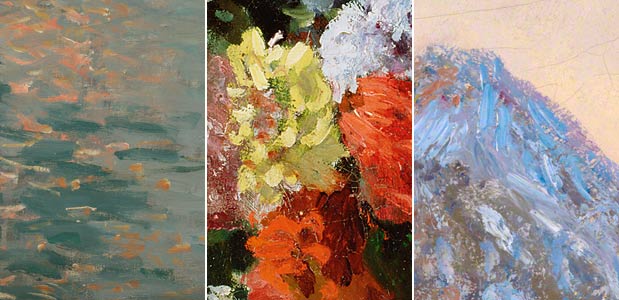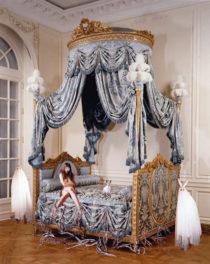Though his name has become synonymous with the 19th century’s canonical movement of Impressionism, and though his masterpieces hang proudly in the halls of the world’s finest museums, Claude Monet has long been—for me—a confounding artist.
He was one of the first whose work spoke to me, both superficially in its sheer beauty—his mastery of paint handling and impasto are irrefutable—but also viscerally, in the way his canvases could transport me to another place and time, so that I too could bear witness to the fleeting moment when the light fell just so on the Houses of Parliament.

Monet’s brushwork in details of paintings from the Getty Museum’s collection. From left: Sunrise (Marine), 1873; Still Life with Flowers and Fruit, 1869; and Wheatstacks, Snow Effect, Morning, 1891
And yet nowadays, I often find myself scarcely pausing before a Monet while spending hours enraptured by a nearby Manet; the two oft-confused contemporary rivals are usually hung in close proximity.
In my case, Monet was a victim of his own success. The proliferation of waterlilies, the Giverny footbridge, and the like on mugs, bags, and even umbrellas, robbed them of their initial power, and rendered the images…almost…hollow.
So when I found myself in Paris in mid-October, I was far more enthused to see the Basquiat retrospective at the Musée d’art moderne de la Ville de Paris than the much-hyped Monet retrospective at the Grand Palais, billed as the first major Monet show in Paris in nearly half a century and the first-ever opportunity to see more than 150 masterpieces at once. “I know Monet,” I thought, “I’ve seen the masterpieces in museums throughout the world. What could I possibly gain from queuing for hours only to have to jockey for a viewing position amidst throngs of Monet fanatics?”
As the old proverb goes, curiosity killed the cat, and I found myself at the entrance to the exhibition one quiet afternoon. Thankfully the queue was minimal and before I could talk myself out of it, I was inside the Grand Palais.
My lack of enthusiasm was immediately upended. I hated to admit it—even to myself—but the works, individually and in mass, were absolutely beautiful. With each passing room (and there were many!), I lingered a little longer before each canvas, slowly rediscovering my youthful passion for Monet.

The Portal of Rouen Cathedral in Morning Light, Claude Monet, 1894
Then I found myself in front of the Rouen Cathedral series. I’d seen two or three before, but never an entire wall. And it was nothing short of magisterial. I marveled at his sophisticated palette with subtle gradations of color; the brilliant white highlights that fashioned form from the formless; shadows made not of traditional black or gray but of purple and blue; and, above all, his completely modern understanding of the uniqueness of context and the singularity of an individual experience, one that is inherently unrepeatable because the weather, light, and other conditions could never be replicated.
I thought of The Portal of Rouen Cathedral in Morning Light (1894) in the Getty’s collection and how many times I’d walked briskly past, failing to give it the pause it so rightly deserved. I would make that mistake no longer.
Thankfully, that afternoon curiosity killed the cat, but more importantly—as the far less-quoted ending of the proverb goes—“satisfaction brought it back.”
Joyeux anniversaire, Monsier Monet!




I wonder sometimes if Monet is deceptively accessible. His work is was the beginning of art journey, and I think that may be common. I learned the fundamentals of Impressionism, saw his work, repeatedly and moved on. He felt boring and liking his work seemed amateurish and I walked right past them clicking off in my head ‘another cathedral, Parliament again, there must be a water lily here somewhere.’ For me, it was a combination of seeing both the Gerome show and the de Young Impressionism show this summer and delving into the art that existed the second half of the 18th century that stopped me in my tracks, the guy was genius.
Monet used to annoy me because of his unbiquity. I used to be a bit of a snob whenever a friend would profess his/her love for Monet. But, now the more I look at his work and really try to understand it, I see him and his genius on a deeper level. His winter pictures, in particular, astonish me.
Thanks Rebecca for your blog! I am heading to Paris for the weekend and also considered skipping the Monet exhibition at the Grand Palais for fear of the queues and turned off by the hype. I will certainly have to pay my respects to Monsieur Monet in light of your post.
@Kim: Deceptively accessible is an eloquent (and accurate) way to describe it!
@kt: The winter pictures are spectacular. His mastery of light and weather are second to none.
@Bryan: Enjoy Paris! There are so many wonderful shows to see right now. In addition to Monet, I highly recommend “Jean-Leon Gerome” at the Orsay (which the Getty co-organized). Insider tip, the Monet queue is the smallest from 4 – 5pm and/or 9 – 10pm. Shhhh, don’t tell 😉